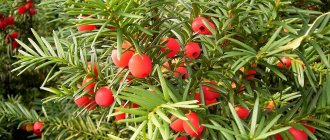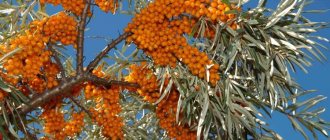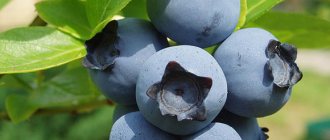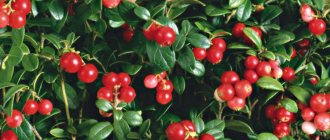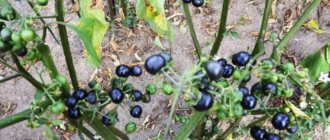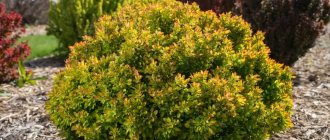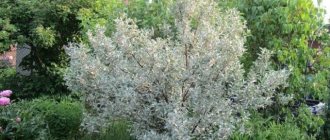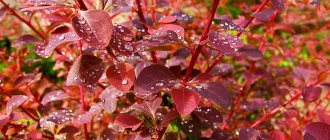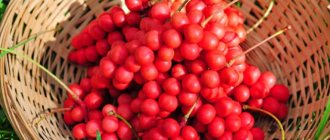Goji berries are incredibly popular among people who want to lose weight and improve their health. Another name for the product is wolfberry or wolfberry. Goji belongs to the Solanaceae family. The berry is actively used to create various supplements and food products aimed at speeding up metabolism and maintaining overall health.
In Chinese, "gouqi" translates to "dereza." That is why in Russia the berry is called Goji. This is how many people translate the word “dereza” from Chinese dialects.
Description of berries and chemical composition
Goji berries are oblong fruits that are red or dark cherry in color. In their external characteristics they resemble barberry. This similarity often becomes a reason for selling cheaper barberry berries as Goji. But with due care, making a mistake is not as easy as it seems. Goji has a lot of seeds inside. Barberry has only 5 of them. Goji tastes sweet and salty, slightly sour.
The benefits of Goji Berry for human health are explained by its rich chemical composition.
It contains 18 amino acids that can inhibit the appearance of age-related changes within the body. The berries contain polysaccharides and protein structures. A large amount of fiber has a positive effect on the functioning of the digestive system. Goji contains B vitamins, proteins and fats, complex carbohydrates, antioxidants, and ascorbic acid. Such a rich chemical composition of berries allows them to be widely used in both regular and medicinal nutrition.
Product components
Goji has long been used in Eastern medicine. Previously, the berries were dried in the sun, and subsequently used to treat colds. They were also used as a general tonic.
It took a long time before scientists studied the composition of the berries. Many useful elements were found in them:
- more than 20 minerals, including vital ones such as magnesium;
- polysaccharides with amino acids;
- beta-carotene;
- protein;
- vitamins B, C, E.
Beneficial properties of Goji berries
The beneficial properties of Goji are widely used in alternative medicine and the normal diet of people. The berries contain vitamin A, thanks to which consumption of wolfberry helps preserve vision and maintain healthy skin.
Goji fruits have a high content of ascorbic acid or vitamin C, even more than lemon.
This component helps strengthen the immune system and overall health of the body.
Regular consumption of Goji helps lower blood sugar levels, so experts recommend consuming berries for diabetes. Also, the Chinese berry is rich in iron; consuming wolfberry is useful for patients with low hemoglobin.
Regular consumption of Goji promotes the following positive effects:
- strengthening the walls of blood vessels;
- cholesterol reduction;
- normalization of glucose levels;
- prevention of the growth of benign and malignant tumors;
- restoration of brain activity;
- normalization of the heart and blood vessels;
- stabilization of blood pressure;
- prevention of atherosclerotic changes in blood vessels;
- improving concentration;
- increasing stress resistance;
- restoration of the hormonal system;
- improving the functioning of the stomach, liver, and intestines;
- acceleration of metabolic processes, faster weight loss.
The berries can be consumed not only fresh, but also the extract can be used. It can be in liquid or powder form. It is added to drinks every day, it is advisable to drink them in the morning. The extract contains all the same properties as fresh fruits.
Indications and contraindications
There are no specific indications for the use of Goji berries. In the absence of an allergic reaction, they can be included in the diet, but in moderation.
It is enough to consume no more than 2-3 tablespoons of dried fruits per day. For powder form, 1 tablespoon is enough.
It is recommended to consume Goji for those who want to speed up metabolic processes and facilitate weight loss, as well as replenish the lack of antioxidants, vitamins and other beneficial substances. Contraindications include individual intolerance to berries.
Seed propagation method
If goji is grown from seeds, the shrub will begin to bear fruit in about 3-4 years. Goji berry seeds are collected from dried berries.
To make it easier to remove them and not damage them, first place the dry fruits in water. They must lie there for some time.
When they become soft, it will be quite easy to get the seeds.
To speed up germination, the seed can be soaked using a growth stimulator.
Next, prepare boxes, pots or other convenient containers and fill their bottoms with drainage. The top is covered with earth. The grooves are made 2-3 cm deep.
Take the seeds and carefully place them on the bottom of the furrows. Sprinkle a little earth on top and cover with glass or film.
For germination, maintain a temperature of 20-25°C.
Seedlings dive at the stage of formation of 3-4 true leaves.
Plants are carefully removed from previous containers.
It is better to replant in separate containers with a small lump of earth.
Next, they are placed in a new place, sprinkled with earth, and watered. Planted in the ground in late spring.
Types and varieties of Goji
Goji or common wolfberry has the following types: Tibetan wolfberry and Chinese wolfberry.
Tibetan wolfberry
This species differs from others in its high productivity. In the first years of planting in a permanent place, the plant begins to bloom and bear fruit. The drop-shaped fruits taste sweet, very juicy and contain large seeds.
Dereza chinensis
Chinese dereza grows as a bush, the plant becomes quite tall and powerful. The fruits themselves have an elongated shape and a sweet taste. The main varieties of Chinese wolfberry: New Big, Lhasa, Sweet Amber and others.
The historical homeland of Goji is China. In the modern world, berries are grown everywhere. Cultivated plants often go wild. Large-scale cultivation of Goji takes place in China.
Chinese goji variety Big Berry
Therapeutic effect
Gadzhi have a complex positive effect on the body. Berries can be consumed at any age if there is no individual intolerance.
Benefits for women
The beneficial properties of wolfberry for women include maintaining optimal metabolic activity. Goji has a positive effect on hormonal function, slows down the aging process, and helps stabilize weight. Modern studies have shown that the berry relieves pain during menstruation, promotes rejuvenation, and prevents the growth of malignant tumors.
Benefits for men
Goji berries are also beneficial for the male body. Consumption of these fruits maintains activity and increases reproductive life . Goji helps normalize blood cholesterol levels, which prevents atherosclerosis - one of the most common and dangerous diseases of middle-aged and elderly men.
Goji during pregnancy
The benefits of Chinese wolfberry during pregnancy have not been fully studied by experts. The lack of definitive data on the safety of Goji requires caution.
The berries do not have toxic properties, but you should consume no more than a tablespoon per day.
Excess can cause allergic reactions.
Goji for weight loss
Goji cannot be considered as an effective remedy for weight loss.
Berries can help normalize weight by increasing the activity of metabolic reactions. Goji also removes toxins, free radicals, and harmful substances from the body, which has a positive effect on overall well-being and increases physical activity.
Berries contain a large amount of fiber, which cleanses the intestines and normalizes the gastrointestinal tract.
To achieve these goals, it is recommended to prepare the following recipe. Pour two glasses of boiled water over a tablespoon of berries and leave to steep for an hour. The water should be slightly warm. High temperatures destroy vitamin C, which is found in large quantities in Goji fruits and has antioxidant and immune-strengthening effects.
Berries and the risk of cancer
Interest in Goji berries is also due to their high content of antioxidants - vitamins C, A and E. They are known to remove free radicals and, to some extent, prevent malignant processes. To reduce the risk of cancer, you can consume both fresh and dried berries, as well as berry juice and Goji powder.
general characteristics
Goji is popularly called “wolf berry”. It should be noted that we call most unfamiliar berries “wolf berries.” This is a collective image that does not carry any special information. The fruits can be both toxic and completely suitable for food consumption. But let's return to goji berries. Lycium barbarum (wolfberry) belongs to the nightshade family and can be used as a food product. The fruits of the plant are consumed more often dried than fresh.
How the common wolfberry got the name goji
The Chinese call the plant Níngxià gǒuqǐ (寧夏枸). Adapted translation - Ningxiang dereza. Goji is a transliteration of the last word gǒuqǐ (in English goji is used) into Russian. English goji is a transcription of the name of the plant from an ancient Chinese dialect, which is adapted to the specifics of the English language. All these names refer to one plant - the common wolfberry (Chinese wolfberry). Each language, acquiring a new word into its vocabulary, tries to organically introduce the term into general linguistic practice (for example, in German the word sounds like bocksdorn).
There are several forms of the word goji in English:
- godji;
- wolfberry
- barbary matrimony vine;
- Duke of Argyll's tea tree.
What does the famous berry look like?
Goji grows as a massive shrub. Its branches are covered with thin spines, and simple, entire leaves take the shape of an ellipse. The shrub produces lilac (the shade can vary from pale pink to deep red or purple) bell-shaped flowers. Crop development occurs between May and September or July and October. The time frame for harvesting depends on the territory, climatic conditions, and humidity. Over the course of several productive months, the shrub produces new fruits 13 times (all this time, the flowers are pollinated by bees twice daily). In the world, the most valuable goji berries are those collected in August. It is believed that they contain the maximum concentration of beneficial substances.
The fruit itself is unremarkable. A small elongated berry in the shape of an oval, colored in a coral-red hue. The berries are widely used in Asian folk medicine. They treat headaches, diseases of the genitourinary system and pathological conditions of the visual organs.
The medicinal effect of goji is multifaceted: not only medicinal decoctions are prepared from them, but also strong alcoholic drinks.
Growing Goji in the garden
If desired, Goji can be grown in your own garden from seeds or cuttings.
The seeds do not need to be prepared in advance. In the spring, they are soaked in warm water for several hours and then planted in moist soil to a depth of 3-4 mm. The soil should contain peat and loam. The seedlings are covered with cellophane on top. You can cover it with a sheet of glass. Then they place the seedlings in a warm place so that the temperature is not lower than 20 degrees. Make sure that the soil does not dry out. After 2 weeks, the first shoots will appear. They are tolerated in a bright place, but protected from direct ultraviolet rays. As soon as the leaves appear, you can transplant the bush to your garden plot. It will grow all year long.
Goji is well insulated for winter. In spring, seedlings can be planted in a permanent place. Young plants begin to bloom a few years after planting, and the berries can be harvested only after 5 years.
Goji can also be propagated from cuttings. Choose woody plants that produce roots faster. Cuttings are taken in summer. Plants are planted in a greenhouse or under film. Growing cuttings are transferred to an unheated veranda or balcony with light insulation. In spring they are planted in open ground.
Maintain a distance between seedlings of at least 1.5 meters. Fill the planting hole with a mixture of soil with humus, superphosphate and wood ash. There should be at least 8 kg of humus, 100-150 g of superphosphate and 30 g of wood ash. Then water the seedlings and compact the top with peat or distillation.
Rules for caring for Goji
Young wolfberry bushes require competent and regular care. The soil near the trunk should not be allowed to dry out too much, but it is not recommended to flood the root system. When it gets cold, you can cover the trunk near the ground with film. An adult plant is watered only during prolonged drought.
Immediately after planting, the plant does not need to be fed. In the future, it is necessary to apply mineral fertilizers or compost several times a year. In order to form the crown, you can do regular pruning in the warm season. It is recommended to remove weak branches first, leaving only the most powerful and healthy ones.
Pests and diseases
Gadjis are not prone to pests. Possible reproduction of aphids and winter cutworms. For prevention and treatment, plants are sprayed with wormwood infusion. Dereza can get powdery mildew. Most often this occurs due to a lack of fertilizing in the form of wood ash. For treatment, wolfberry is treated with fungicidal compounds.
Planting seedlings
To grow wolfberry from seedlings, holes should be dug in advance at least 40 cm in diameter and 50 cm in depth. The hole is half filled with a mixture of sand, fertile soil and humus; in addition, you can add superphosphate or potassium fertilizer or wood ash.
When planting, the root collar of the plant should be at soil level, the seedling is sprinkled with earth and watered. The distance between seedlings should be approximately 2 meters.
Collection and storage of berries
The fruits are collected after they are brightly colored dark red. It is recommended to lay a cloth under the bush where the berries will fall after being knocked down. Hands must be protected with gloves.
Clean the berries from leaves and branches and scatter them in a cool, dark place for further drying. After a few days, you can tear off the stalks, after which drying continues. Turn the berries over and stir regularly so that they dry evenly. When the skin begins to fall off, this is a sign of well-dried raw materials . Store dry fruits in a glass or ceramic container with a ground-in lid. Fresh berries can be frozen and used in winter to prepare various dishes.
Goji smoothie
You can make a healthy smoothie from Goji berries. To do this, you can use wolfberry fruits either separately or in combination with other fruits and berries. Traditional smoothie recipe: Take a glass of fruit tea or coconut water. Add a glass of any frozen berries and half a glass of dried Goji fruits. All ingredients must be blended in a blender until a homogeneous consistency is obtained. If desired, you can sweeten the drink.
Care
Since dereza is unpretentious, caring for goji berries is easy. It grows well even in areas with the poorest soil, but produces the best fruits when grown on more fertile soil.
At the same time, only young seedlings should be fed; goji does not need any further fertilizers. It does not tolerate wolfberry and excess moisture, so water it 1-2 times a week.
Over time, the goji bush grows very actively and requires regular pruning. It responds well to pruning, so it can also be cultivated for decorative purposes.
Myths about Chinese wolfberry
Recently, the sale of Goji berries has become a commercial project. The benefits of Chinese wolfberry have been greatly exaggerated. Many weight loss products that contain Goji berries do not provide the stunning effect that the consumer expects. Dereza cannot in any way cause sudden weight loss.
Also, Goji is not a panacea for all diseases. The berry contains a large amount of nutrients and antioxidants, but this does not make Goji a truly healing plant.
Another common myth is that berries contain 500 times more vitamin C than oranges and lemons. These figures are greatly exaggerated. A glass of orange juice contains approximately 150 mg of ascorbic acid, while Goji juice contains 250 mg.
